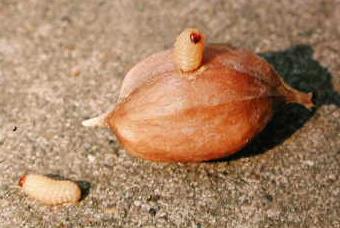| 10-16-06
Several readers have inquired about how to collect
hickory nut worms as ice-fishing bait, how to keep them happy and healthy
until ice comes, and, of course, how to fish them when the snow blows in
to make safe ice.
It has been several years since I discovered this
tiny maggotís value as ice bait, so I will try to answer the questions
that have come our way since. Itís a popular topic, all the more-so when
the weatherman starts us thinking of hard-water angling.
First, I think something about this insectís larval
stage is much in order at this point. It is the larva of what I have heard
called he hickory nut weevil, and is decidedly a member of the weevil family.
I have heard people refer to the hickory nut weevil many times, but as
best we can find, it does not exist. There is no such critter out there.
There are about as many weevils as there are Heinz Soups, and most of them
create larvae that look like the one that at times infests hickory nuts.
It does definitely exist (thank heaven for super ice bait). And, this weevil
larva, or one that is very similar in looks, will also be found in some
other nuts, mainly the acorns of some black oaks.
So the hickory-nut weevil does not exist, and
you will find them (if you are lucky) in some hickory nuts and in other
nuts. Excuse me if that sounds a bit like Stenglease. Itís the best I can
do with the family.
The origin of the hickory-nut weevil, about a
quarter of an inch in length and an eighth of an inch wide, is said by
varying expert sources to occur in no less than two ways. It supposedly
deposits its egges in the bloom or the nut. I will not attempt to determine
which, if either, may be correct, or if there are other methods of getting
the eggs (one to three or four) inside the nut. However the egg gets there,
it hatches and develops into the ultra-clean maggot (if you still are a
smidgen tolerant.). Honest, they are clean. I have known a few ice anglers
who kept spare baits between the lip and teeth to keep them warm and have
a few spare baits handy. They are not real tasty, they say.
Anyhow, the eggs hatch and the larva (larvae)
feeds on the kernel of the nut until fall when it chews a neat little hole
(less than 1/8 inch) through the nut (inner and outer shells and hulls)
to burrow into the earth, winter over, and start this most-interesting
scenario all over again after emerging as adult weevils some time later.
Incidentally, the weevil looks nothing like the hickory nut worm. When
this metamorphosis occurs is not quite clear, but it may occur in winter
or spring in the earth.
I keep them in those little 35 mm.film cans along
with a little corn meal and refrigerate the cans (no freezing). This, by
the way, is a weakness of digital photography. My wife used to ask what
was in the cans, and I always told her what I call hickory nut worm lies,
until she cleaned the frig one day and discovered my lack of veracity.
Keep them at 40 degrees and donít stretch your luck on the frig..
Baiting hickory nut worms is quite simple.
One uses a very small hook, of course; like the
hook of a small ice jig. Just punch them on the point or push the hook
through both sides of the worm and let them ride the bend of the hook.
Put them close to the bottom; thatís where bluegills usually stay. Incidentally,
2-4 pound test monofilament is a good line. Before mono was invented the
ice-fishing line was usually horseís mane or tail. Needless to say, horses
got a little skittish the winter as you approached with that ice-fishing
sneer on your face.
Harvesting a winterís supply of hickory nut worms
is fairly simple at this time of year. Just pick up nuts that fall under
your favorite hickory tree and put them in a paper grocery bag. The worms
will chew their way out of the nuts at room temperature. Keep the bags
in metal container and each morning for a week or so you will find your
baits in the metal container. I used to keep track of trees that have wormy
nuts, but my efforts did not tell me anything worthwhile. All trees sport
some wormy nuts, some more than others.
Whatta you do with the nuts that donít have worms?
Easy game, coach! Just turn the kernels into pies,
cookies, cake, fudge or many other gourmet items, or just snacks. They
are surpassed only by the worms. Eating them will keep one as regular as
Big Ben.
 |
These worms are slightly smaller than they appear--slightly
less than a half inch long and an eighth if an inch wide. |
|

